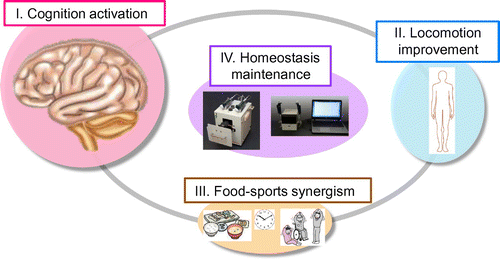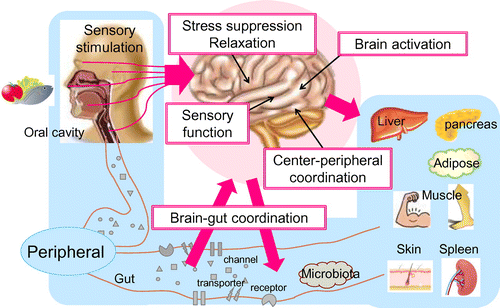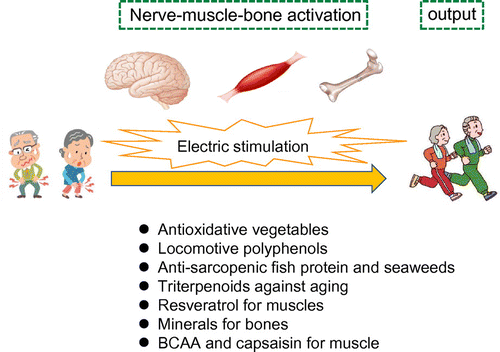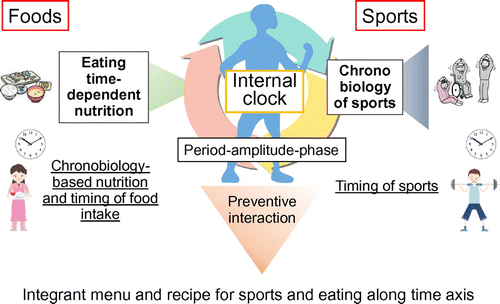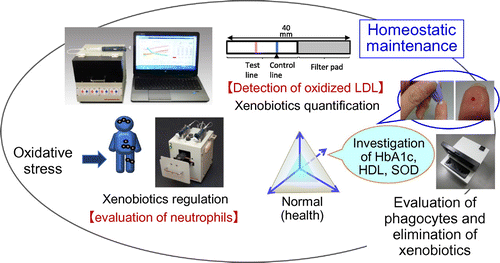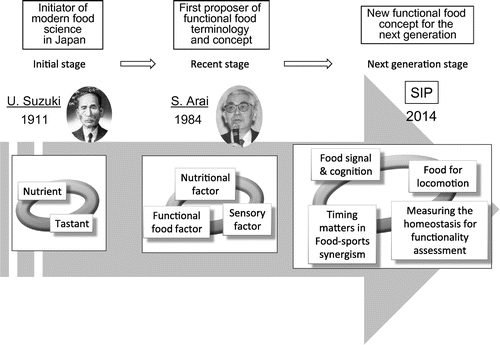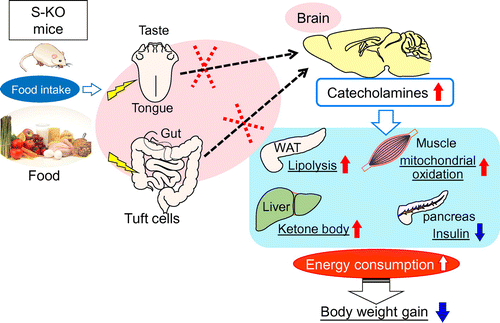Abstract
In Japan, where a super-aging society is realized, we are most concerned about healthy longevity, which would ascertain the wellness of people by improving their quality of life (QOL). In 2014, the Cabinet Office proposed a strategic innovation promotion programme, launching a national project for the development of the agricultural-forestry-fisheries food products with new functionalities for the next generation. In addition to focusing on a conventional prevention of lifestyle-associated metabolic syndromes, the project targets the scientific evidence of the activation of brain cognitive ability and the improvement of bodily locomotive function. The project also involves the analysis of the foods-sports interrelation of chronic importance, and the development of devices for the verification of QOL-associated maintenance of homeostasis. In this review, we provide an overview of these studies, with special reference to cognition as a case of the gut-brain axis which the author is particularly interested in.
Incollaboration with current studies on functional foods, a new science in the relevant area has started as a national project with four research platforms.
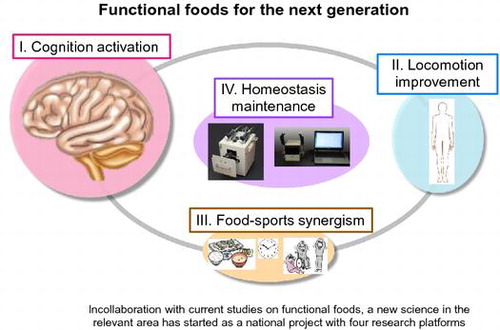
Introductory remarks
In Japan about 100 years ago, two breakthroughs were made in the nutritional and food science fields. The first one was made by Dr. Umetaro Suzuki, who identified an anti-beriberi factor, named oryzanin, in rice bran [Citation1]. Oryzanin was later renamed thiamine, the first vitamin, since it was found to be a nutritionally essential universal molecule that catalyses the decomposition of pyruvate into acetyl-CoA; the latter plays a central role in the catabolism of sugars and lipids. The other breakthrough was made by Dr. Kikunae Ikeda, who identified monosodium l-glutamate in kombu seaweed; its production was then industrialized to form a seasoning company. Since then, the two findings contributed to the formation of the two main streams of food science and technology in Japan, as well as in many other countries.
The third stream came into being almost 30 years ago. It accompanied the social context of the growing number of countries with aging people and the increasing public concern about health. Accordingly, an idea that originated in ancient China and Japan, that medicine and food are isogenic, experienced resurgence. Food is now recognized as supplying more than the usual nutrients; it can help reduce the risk of lifestyle-related diseases and the associated abnormal modalities, such as the metabolic syndromes that lead to obesity, diabetes, hypertension, and other disorders, as well as immunological disorders that may cause cancer, allergy, infections, disease, and so on. The current trend of reconsidering the food as a first line of defence against these diseases is becoming stronger with the increasing understanding of food-induced health benefits [Citation2].
Against this backdrop, the term “functional food” and its concept were first proposed in Japan and large-scale national projects “Systematic analysis and development of food functionalities” (1984–1987) and “Analysis of the body-modulating functions of foods” (1988–1991) were implemented under the sponsorship of the Ministry of Education, Science, and Culture. One of the representative results of the project was the identification of oryzacystatin as a tangible example of a functional food component; it is the first cystatin (i.e. proteinaceous cysteine proteinase inhibitor) of plant origin [Citation3–6] that defends the human body from infection, in this case, the human herpes virus [Citation7]. One typical functional food product derived from the project was hypoallergenic rice grain effective against the normal rice-associated atopic dermatitis spreading in Japan [Citation8,9]. Upon evaluation in a clinical intervention test, the rice was approved as the first “food for specified health use” product in 1993; it was now re-categorized as a “food for medical purposes” by new legislation of the Japan Ministry of Health and Welfare [Citation10]. The-state-of-the art was introduced by the Nature journal with the headline “Japan explores the boundary between food and medicine”, reminiscent of the old Chinese saying mentioned above.
Next generation-directed programme
The innovation council for comprehensive science and technology polices of the Japan Cabinet Office launched a strategic innovation promotion programme (SIP) in 2014 to govern the Japan-specific economical and industrial themes of crucial scientific importance from basic study to applications in a cross-ministerial fashion. Similarly to the already mentioned projects, the SIP is a 5-year national project, running from October 2014 to March 2019. It incorporates the next-generation policies for technological creation in the agriculture-forestry-fisheries (AFF) field as an AFF SIP programme, which is a section of a total of 11 programs.
The AFF SIP comprises two categories (Table ). One of these shares a consortium with the subject “Creation of value-added AFF products by development of new food functionality”, with special reference to “the development of functional food products for the next generation”.
Table 1. Ongoing project of the Ministry of Agriculture, Forestry and Fisheries (MAFF).
In our country, the super-aging society is growing at a constantly increasing, immense rate. This necessitates the maintenance and improvement of the quality of life (QOL) of the highly-aged individuals in particular. In general, the realization of active societies for all the people counting for 100 million is highly expected. This status is based on the maintenance of human homeostasis by eating. However, the conventional functional food studies are interested in improving the metabolic syndromes primarily by the use of antioxidants. In addition, the new science of functional foods for the next generation necessitates the exploration of the improvement of cognitive abilities of the brain, e.g. memory and cognitive response, and amelioration of body locomotion by building up defence against sarcopenia, bone fracture, and others. These approaches imply the importance of health maintenance by homeostatic care. It also refers to maintaining a pre-disease status rather than preventing lifestyle-related diseases by food and treating those by medicine. The use of appropriate foods would be the most desirable solution for pre-disease state maintenance. Hence, the manner of selecting foods for this purpose should become the focus of new research. The overarching aim of the SIP is to develop some AFF food products for the next generation, in particular, the development of functional food factors to improve the QOL by the activation of cognitive ability and locomotion. The national project is expected to identify these factors in AFF products and to analyse, evaluate, and scientifically ascertain their functions. The ascertainment of scientific evidence through a collaboration of universities, ministries, and industries will no doubt lead to the development and commercialization of some new functional food factors that would be acceptable to the consumer. The AFF SIP set up four platforms for efficient research (Figure ).
Platforms in the project on the next generation functional foods
Platform I (cognition improvement), headed by Takumi Misaka (the University of Tokyo), focuses on a project entitled “Development of functional AFF food products for the activation of brain cognitive ability”. It is involved in work on next-generation AFF food products with new functions. In particular, it focuses on the improvement of the QOL of pre-disease human subjects by the activation of brain functions and also by prevention of cognitive deterioration, improvement of memory ability, elucidation of the gut-brain coordination, peripheral-central correlation, nutrition-preference-behaviour correlation, and so on. In the course of the project, scientific evidence for the steering and directing functions of the brain will be uncovered, with special reference to the functional food science for the next generation. A number of papers have already been published [Citation11–36] (Figure ).
Clarification of the brain activation functions of common food factors are extremely important to this research platform. Specifically, it was found that γ-oryzanol that occurs in unpolished rice grains elicits a variety of functions in the body, removing the obesity and diabetes by regulating the dopamine pathway [Citation36–39]. Furthermore, the traditional Japanese soy sauce and rice wine fermentation by-products were found to function as anti-aging agents, and to mitigate longevity-associated lifestyle-related disease [Citation40,41]. Further, rosmarinic acid in lemon balm was found to delay the onset of Alzheimer’s disease, a disease that is a cause of great concern in super-aging societies [Citation42,43]. In addition, some absorption-resistant polyphenols, as minor food components, have been shown to induce stimulation of the sympathetic nerves via a gut receptor recognition [Citation20,44–49]. These types of new data on cognitive activation will provide clues to the production of AFF foods containing higher amounts of functional factors than regular foods. This is also an important proposition for the food-aided healthy longevity. We aim to enable the world to recognize again the concept of Japanese next-generation functional food products.
Platform II (locomotion improvement), headed by Ryuichiro Sato (the University of Tokyo), is aimed at producing functional foods for the next generation that will contribute to the maintenance of the bodily locomotive ability. Highly-aged individuals experience locomotive disability in their daily lives and, therefore, require health care every day. This was the driving force for recognizing the importance of identifying why such a bodily disability occurs and the countermeasures required to remove or mitigate this problem. Thus far, it is known that the disability may stem from a decrease in muscle mass, which leads to sarcopenia, and that an improved locomotive ability and proper diet could contribute to the amelioration of this disability. Further, the maintenance of bone metabolism to remove joint impairment should be considered as an associated factor for the locomotive disability. Some functional factors exist in common foods, which can elicit effect or efficacy. It is thus necessary to identify some particularly desirable food components and develop them in AFF food items for application to QOL improvement (Figure ). A number of papers have already been published [Citation50–69].
Special research results are highlighted below. One outstanding finding was a significantly increased expression of irisin, as a brain-originating neural nutrient involved in the cognitive function, during electric stimulation of the human skeletal muscle. Further, a clinical test with healthy old subjects revealed that olive-pomace oil contains maslinic acid that is very effective in improving their locomotive ability. On the other hand, a basic experiment demonstrated that caffeine and gallate accelerate human metabolism. Administration of aronia can also accelerate an acute movement-resistant muscle anabolism without affecting the muscle catabolism. A model of screening a target protein, e.g. collagen, was established, enabling the identification of several trace compounds that suppress AGE production and those with a pronounced ability to decompose AGEs [Citation67–69]. With a specific reference to the skeletal muscle, the muscle mass is increased by a limonoid in citrus fruits that functions as an agonist for a bile acid receptor TGR5 in mice [Citation70]. The molecular mechanism by which some limonoids interact with human TGR5 was fully elucidated [Citation71]. Furthermore, intake of resveratrol, together with systematically charging the locomotion ability, was found to be associated with the up-regulation of genes for lipid metabolism and the enhancement of movement ability. All these findings may possibly contribute to obtaining a clue for applied studies in the near future.
Platform III (chronobiology-based nutrition), headed by Shigenobu Shibata (Waseda University), involves a study entitled “Timing matters for food intake and exercise”, which is focused on the interaction between food and chronobiology-based nutrition. The expression of food functions is highly time-dependent. This study is based on the notion that the functions involved in brain cognition and bodily locomotion are time-dependent. The circadian clock, which controls the sleep/wake cycle, is affected by external cues, including the light and darkness, as well as food intake, stress, and exercise. Dysregulation of the circadian cycle is linked to disorders, such as obesity and diabetes [Citation72,73]. To devise a menu that would allow an investigation of the food-exercise interactions, a trial is currently in progress in school feeding centres and aged people’s facilities. For an IT-aided recipe preparation and sports programming, technologies for acceleration sensors, location information, and picture imaging are continuously investigated (Figure ).
A number of papers have been already published [Citation72–80]. The internal clock of research animals can be altered in the laboratory by restricted feeding and scheduled exercise cycles [Citation73–75]. Mice that receive breakfast which is more protein-rich than dinner exhibit a more pronounced increase in the skeletal muscle volume. Likewise, morning exercise is most beneficial. Mice released for exercise in the morning show better muscle recovery than those released at noon or in the evening. The morning light is known to be a strong extrinsic cue for the suprachiasmatic nucleus clock, the main oscillator in the brain. Morning exercise and feeding are known cues for the peripheral organ clocks. Ingestion of nobiletin, γ-oryzanol (a ferulic acid derivative), DHA/EPA, etc., in the morning is associated with increased periodic time and the phase adjustment, whereas calcium and isoflavones should be taken in the evening. A systematic investigation involving human subjects revealed that highly-aged individuals with an early rising practice tend to become obese because of a short interval between dinner and the beginning of sleep. Further, inulin intake in the morning leads to reduced HbA1c levels, and increased erythrocyte count. Programming for chronobiology-based nutrition and sports is also on-going, from an aspect of a metabowatch.
Platform IV (new functionality analysis), headed by Gen-Ichiro Soma (Control of Innate Immunity Technology Research Association), investigates bodily homeostasis for the assessment of food functionalities. A number of papers and patents have been produced [Citation81–95]. To evaluate various aspects of the effect of AFF food products and sports on the bodily homeostasis, in addition to the usual biochemical testing, a basic system was constructed that enables using trace amounts (μl) of untreated blood samples for neutrophil, oxidized LDL, and phagocyte analyses. The research group involved in this platform has also proposed an integrated protocol for the use of blood samples of animal and human origin. The most important accomplishments of the group thus far include (1) the first-ever patent pertaining to a construction of a device that can be used for simultaneous measurement of superoxide and myeloperoxidase activities [Citation92,95]; (2) detection of oxidized LDL in human plasma using oxidized LDL receptor that is engineered in transgenic silkworms (detection limit: 10 ng/ml) [Citation82,87,91,93]; and (3) construction of a first-ever double-tube device for measuring phagocytosis [Citation83,90,94] in the human peripheral blood. The members of the group are collaborating with platform I, II, and III group members to detect correlations between conventional biochemical parameters and these homeostasis monitoring factors (Figure ).
To summarize, the mainstay of the food science in Japan has thus followed a unique path of development, by way of lateral and trilateral processes, to occupy a central position of the national SIP project, as spotlighted in the Nature journal [Citation96] (Figure ).
Two additional notes on platform I-related cases of particular interest
The role of foods in cognition and brain function
The main objective of the SIP research project is to propose a novel concept on the intake of functional foods containing specific effective compounds. The researchers involved analyse the molecular mechanisms that underpin the activation of brain functions by functional foods or their effective compounds, to clarify the functionalities of peripheral organs induced by brain activation. This research project is unique in that professionals from different backgrounds are participating in it; these include food scientists, medical doctors, physiologists, and bioinformatics scientists, among others, who examine a diverse range of issues, from basic science to applications.
In many developed countries, age is regarded as a critical risk factor. Therefore, people desire to learn about the possible ways of extending a healthy life expectancy. Alzheimer’s disease is one of the most common forms of dementia, resulting in cognitive impairment and behavioural changes. To date, the SIP research group members, including Shoko Kobayashi (the University of Tokyo), Masahito Yamada (the Kanazawa University Graduate School of Medical Sciences), and colleagues have provided scientific evidence that some compounds, and, subsequently, food materials, may reduce defects in our healthy state. When natural phenolic compounds, such as rosmarinic acid, were administered in the mouse model of Alzheimer’s disease for 10 months, and the cerebral plaque burden and the formation of amyloid β oligomers were then compared, a significant reduction in amyloid β-protein deposition was clearly observed in the brain of mice fed rosmarinic acid. This suggests that oral administration of phenolic compounds prevents the development of Alzheimer’s disease pathology by controlling amyloid β aggregation in the mouse model [Citation97]. In addition, the safety, tolerability, and pharmacokinetics of lemon balm extract, which contains high quantities of rosmarinic acid, were also examined in healthy individuals between 20 and 31-years-old [Citation42]. Rosmarinic acid supplementation did not affect the liver, kidney, or blood cell functions, and no adverse events associated with the treatment were reported by any of the participants. Further studies are required to investigate the safety of long-term rosmarinic acid use, as well as its effects on the cognitive performance of patients with Alzheimer’s disease. Nevertheless, the potential of natural phenolic compounds for the prevention of the disease is strongly indicated by these studies.
Furthermore, the foods that are daily consumed by human also contain function compounds. It is well known that germinated brown rice is rich in bioactive molecules that exert significant effects on many metabolic disorders. Hiroaki Masuzaki et al. (University of the Ryukyus) evaluated the effects of brown rice consumption on abdominal fat distribution, metabolic parameters, and endothelial function in patients with a metabolic syndrome. The study demonstrated that the consumption of brown rice is beneficial partly because it lowers the glycaemic response. This indicates that brown rice consumption may protect the postprandial endothelial function in subjects with metabolic syndrome [Citation37]. The researchers also tested the hypothesis that brown rice specifically contains several metabolically beneficial compounds not found in other grains. In fact, γ-oryzanol, a mixture of ferulic acid esters and phytosterols, is one of the major bioactive components in rice bran. The effects of brown rice and γ-oryzanol on the feeding behaviour and homeostasis in mouse were also investigated; the study indicated that the diets improved glucose metabolism, reduced hypothalamic endoplasmic reticulum stress, and, consequently, attenuated the preference for dietary fat in mice fed high-fat diets [Citation38] (HFD). These observations demonstrated that brown rice and γ-oryzanol may improve glucose dysmetabolism induced by HFD, and attenuate the preference for dietary fat by decreasing the hypothalamic stress, suggesting that brown rice and its extracts may be useful tools for ameliorating the obesity and metabolic syndrome by changing the function of the brain activity.
Analysis of the gut-brain axis in a study of food-induced energy homeostasis
Animals maintain the peripheral energy homeostasis by modulating their eating behaviours in response to nutritional changes in the body. During sufficient nutrient intake, the animals utilize glucose as an energy source; some excess of the glucose is stored, with the eating behaviours controlled. During insufficient nutrition (e.g. fasting), the stored lipids are used for bodily energy supply, with the behaviours to alleviate hunger accelerated. Hence, the induced peripheral energy homeostasis can be strictly regulated by hormonal and neural actions governed by cerebral stimuli. Food intake is a crucially important factor for energy homeostasis. For this, sensory factors are included to the senses of sight, smell, taste, and texture. In particular, taste is the only sense that operates at the time of eating, and influences the quality and quantity of consumed food [Citation98]. It is thus highly associated with energy metabolism. Further, a variety of food-borne compounds can interact with the gut and the consequent stimulation taking place in the gut evoke some physiological functions [Citation99]. Not only food digestion and absorption, but also energy metabolism are modulated by the gut. Most food signals received in the oral cavity and the gut are transmitted to the brain, which then reacts to induce energy metabolism. In this case, the coordination between the gut and the brain may take place closely. However, the details of this coordination have long remained unclear.
To elucidate the effects of taste stimulation on eating behaviours, experiments were carried out using wild type (WT) mice and Skn-1a knockout (S-KO) mice which we ourselves had developed [Citation100]. Incidentally, Skn-1a is a transcription factor expressed in taste cells; it is involved in the differentiation of sweet, bitter, and umami taste receptors cells [Citation100]. These cells are not present in S-KO mice, and the animals fail to receive sweet, bitter, and umami tastants, with the consequent increase of the sour taste cells. Experiments were first conducted with WT mice to observe changes in food intake. The bitter tastant intake was reduced without any changes in the preference for the umami tastant. The intake of the aversive tastant by S-KO mice was similar to WT mice; however, the intake ratio was reduced in S-KO mice. The involvement of taste stimulation in food selection was then verified by simultaneous presentation of animals with two kinds of foods with different taste modalities (the two-bottle test). Only the WT mice exhibited a taste-dependent preference for sweetness, and both WT and S-KO mice tended to be averse to bitterness, although a degree of aversion in S-KO mice was low compared to WT mice. These example observations may verify the notion that taste stimulation influences food selection. Taken together, animals prioritize energy intake to taste stimulation so that the taste rather than taste preference contributes to food selection. In contrast, aversive tastes such as bitterness take part in the decision of preference or aversion, and indicate a priority of the taste modality for energy intake. Further, it is likely that S-KO mice showed a certain degree of aversion to bitter taste and, therefore, a chemoreception system besides oral cavity.
Sweet taste reception is the first process that detects sugar as a calorie source. Recently, however, it has been reported that the intake of a non-calorie sweetener synthesized chemically may lead to body weight increase [Citation101–105]. This suggests the possibility that the sweet taste stimulus itself affects the homeostasis. The correlation between the sweet taste stimulation and energy metabolism was investigated on the level of hepatic gene expression. WT mice were given a saccharin solution per os; the solution was also introduced directly into the stomach of some WT mice. Gene expression in the liver of each WT mouse was analysed by DNA microarrays 6 h after the stimulation. The expression of genes associated with fatty acid β-oxidation was up-regulated to a greater extent in the livers of mice that had been given the solution orally than in the other animal group. To investigate whether this up-regulation is due to the sweet taste stimulation or not, a similar experiment was performed using S-KO mice; the up-regulation of lipid metabolism-associated genes was not observed in this mouse model. This implies that the sweet taste signal generated in the oral cavity is transmitted to the brain, following which the hepatic gene expression is altered. A pathway of such a feedback from the brain to the liver was investigated; no such gene expression change occurred in mice with hepatic branch excisions. This observation also suggests the existence of a new pathway of the feedback. Briefly, the sweet taste stimulus is affluently transduced to the brain by the vagal nerve and also directly influences hepatic nutrient metabolism as a part of energy source. Re-evaluation of the function of non-calorie sweeteners may be required.
No significant difference in body weight at birth is observed between S-KO mice and WT mice. On the other hand, the body weight of S-KO mice is lower than WT mice during 16 weeks after weaning. However, no significant difference in the food intake of S-KO and WT mice is observed. This suggests the importance of S-KO mouse as a model for studying energy homeostasis [Citation106].
Skn-1a is expressed in the gut, the stomach and the intestine, and also in the oral taste buds. It is not expressed in the spleen, islets of Langerhans, liver, muscle, WAT, BAT, and brain. Enterocytes, Goblet cells, Paneth cells, enteroendocrine cells, and brush cells are all present in the gut epithelium [Citation107,108]. Histological studies of markers expressed in these cells revealed that the gut brush cells of S-KO mice lack most such markers. This indicates that the taste and brush cells of the gastrointestinal tract (GI) are not present in S-KO mice.
Metabolic phenotypes of S-KO mice fed a chow diet were also characterized to analyse the effect of eliminating the taste and brush cells from the GI on energy homeostasis. X-ray computed tomography (CT) analysis of body composition revealed that the body fat percentage of S-KO mice was lower than in WT mice, whereas there was no significant difference in the muscular mass percentage. Chemical analyses of the blood indicated that the total levels of serum ketone bodies were significantly higher in S-KO mice than in WT mice. Also, cholesterol and non-esterified fatty acid levels tended to be higher in S-KO mice. These observations indicate that lipid metabolism, such as lipid degradation and β-oxidation of fatty acids, is accelerated in S-KO mice. Analysis of the metabolic rate in mice revealed that the energy expenditure of S-KO mice was higher than in WT mice, although no significant differences in the respiratory exchange ratio and motor activity were noted [Citation106].
The body weight and body fat percentage were dramatically reduced in S-KO mice fed HFD, similarly to mice fed a chow diet, whereas no significant differences in the muscle weigh ratios were observed. The energy expenditure was also higher in S-KO mice than in WT mice, but food intake and motor activity were similar. These data suggest that increased energy expenditure is the primary cause of reduced adiposity in S-KO mice fed HFD [Citation106]. The involvement of thyroid hormones and catecholamine in lipid metabolism was next investigated. No difference in thyroid hormone levels in the blood was apparent in the two types of mice, but urinary epinephrine, dopamine, and norepinephrine levels were higher in S-KO mice than in WT mice [Citation106]. The expression of gene encoding catecholamine biosynthesis enzymes in the adrenal glands was comparable in WT and S-KO mice, indicating that catecholamine is over-secreted by the adrenal glands in S-KO mice. This event may accelerate lipolysis.
To examine carbohydrate metabolism in S-KO mice, the oral glucose tolerance test (OGTT) was performed. Compared with WT mice, blood glucose levels were significantly lower in S-KO mice for 120 min after OGTT; further, plasma insulin levels were lower in S-KO mice before glucose administration and tended to be lower 15 min after OGTT. These observations demonstrated that the insulin resistance and impaired glucose tolerance observed in WT mice fed HFD are ameliorated in S-KO mice [Citation106] (Figure ).
In a network of the gut-brain axis, the loss of brush cells and taste cells in the GI tract can alter the energy metabolism in Skn-1-deficient mice. Taste receiving cells in the oral cavity and brush cells in the gut that receive food-borne chemicals are involved in the regulation of body weight and adiposity. Hence, the sense of taste and energy metabolism are cross-linked. Consequently, the gut-brain axis is extremely important in the future of functional food science. This means that functional foods for the next generation should be considered from the viewpoint of integration of nutrition, palatability, and physiological functionality.
The SIP approach overviewed herein will no doubt contribute to the development of AFF functional foods for the next generation.
Disclosure statement
No potential conflict of interest was reported by the authors.
Funding
This work was supported by the Japan Council for Science, Technology, and Innovation (CSTI) as a Cross-Ministerial Strategic Innovation Promotion Program (SIP) with respect to “Technologies for creating next-generation agriculture, forestry, and fisheries” [funding agency: Bio-Oriented Technology Research Advancement Institution, NARO].
Acknowledgements
The authors give special thanks to Dr. Soichi Arai (Tokyo University of Agriculture) who joined us in pertinent discussions at the time of writing. We also thank the scientists collaborating with us on the SIP project and those working on the gut-brain axis study. These include Dr. Ryuichiro Sato (the University of Tokyo), Dr. Shigenobu Shibata (Waseda University), Dr. Gen-ichiro Soma (Control of Innate Immunity, TRA); Drs. Shota Ushiama, Yoshiro Ishimaru, and Masataka Narukawa (The University of Tokyo); and Drs. Hiroaki Masuzaki and Chisayo Kozuka (University of the Ryukyus).
References
- Suzuki U, Shimamura T, Okada S. Über Oryzanin, ein Bestandteil der Reiskleie und sein physiologische Bedeutung. Biochem Z. 1912;43:89–153.
- Arai S. Studies on functional foods in Japan—state of the art. Biosci Biotechnol Biochem. 1996;60:9–15.10.1271/bbb.60.9
- Abe K, Arai S. Purification of a cysteine proteinase inhibitor from rice, Oryza sativa L. japonica. Agric Biol Chem. 1985;49:3349–3350.
- Abe K, Emori Y, Kondo H, et al. Molecular cloning of a cysteine proteinase inhibitor of rice (oryzacystatin). Homology with animal cystatins and transient expression in the ripening process of rice seeds. J Biol Chem. 1987;262:16793–16797.
- Kondo H, Ijiri S, Abe K, et al. Inhibitory effect of oryzacystatins and a truncation mutant on the replication of poliovirus in infected Vero cells. FEBS Lett. 1992;299:48–50.10.1016/0014-5793(92)80097-Z
- Misaka T, Kuroda M, Iwabuchi K, et al. Soyacystatin, a novel cysteine proteinase inhibitor in soybean, is distinct in protein structure and gene organization from other cystatins of animal and plant origin. Eur J Biochem. 1996;240:609–614.
- Aoki H, Akaike T, Abe K, et al. Antiviral effect of oryzacystatin, a proteinase inhibitor in rice, against herpes simplex virus type 1 in vitro and in vivo. Antimicrob Agent Chemother. 1995;39:846–849.10.1128/AAC.39.4.846
- Watanabe M, Miyakawa J, Ikezawa Z, et al. Production of hypoallergenic rice by enzymatic decomposition of constituent proteins. J. Food Sci. 1990;55:781–783.10.1111/jfds.1990.55.issue-3
- Watanabe M, Yoshizawa T, Miyakawa J, et al. Quality improvement and evaluation of hypoallergenic rice grains. J Food Sci. 1990;55:1105–1107.
- Swinbanks D, O’Brien J. Japan explores the boundary between food and medicine. Nature. 1993;364:180.
- Cui Y, Toyoda H, Sako T, et al. A voxel-based analysis of brain activity in high-order trigeminal pathway in the rat induced by cortical spreading depression. NeuroImage. 2015;108:17–22.10.1016/j.neuroimage.2014.12.047
- Goto T, Kubota Y, Toyoda A. Plasma and liver metabolic profiles in mice subjected to subchronic and mild social defeat stress. J Proteome Res. 2015;14:1025–1032.10.1021/pr501044 k
- Blackledge NP, Farcas AM, Kondo T, et al. Variant PRC1 complex-dependent H2A ubiquitylation drives PRC2 recruitment and polycomb domain formation. Cell. 2014;157:1445–1459.10.1016/j.cell.2014.05.004
- Fort A, Yamada D, Hashimoto K, et al. Nuclear transcriptome profiling of induced pluripotent stem cells and embryonic stem cells identify non-coding loci resistant to reprogramming. Cell Cycle. 2015;14:1148–1155.10.4161/15384101.2014.988031
- Hara H, Yokosuka T, Hirakawa H, et al. Clustering of CARMA1 through SH3-GUK domain interactions is required for its activation of NF-kB signaling. Nature Commun. 2015;6:5555.10.1038/ncomms6555
- Nakamura S, Satoh H, Ohtsubo K. Development of formulae for estimating amylose content, amylopectin chain length distribution, and resistant starch content based on the iodine absorption curve of rice starch. Biosci Biotechnol Biochem. 2015;79:443–455.10.1080/09168451.2014.978257
- Oishi Y, Yoshida K, Scammell TE, et al. The roles of prostaglandin E2 and D2 in lipopolysaccharide-mediated changes in sleep. Brain Behav Immun. 2014;47:172–177.
- Trimarco A, Forese MG, Alfieri V, et al. Prostaglandin D2 synthase/GPR44: a signaling axis in PNS myelination. Nat Neurosci. 2014;17:1682–1692.10.1038/nn.3857
- Nakajima K, Cui Z, Li C, et al. Gs-coupled GPCR signalling in AgRP neurons triggers sustained increase in food intake. Nat Commun. 2016;7:10268.10.1038/ncomms10268
- Kamio N, Suzuki T, Watanabe Y, et al. A single oral dose of flavan-3-ols enhances energy expenditure by sympathetic nerve stimulation in mice. Free Radic Biol Med. 2016;91:256–263.10.1016/j.freeradbiomed.2015.12.030
- Atarashi K, Tanoue T, Ando M, et al. Th17 cell induction by adhesion of microbes to intestinal epithelial cells. Cell. 2015;163:367–380.10.1016/j.cell.2015.08.058
- Yakushiji-Kaminatsui N., Kondo T, Endo TA, et al. RING1 proteins contribute to early proximal-distal specification of the forlimb bud by restricting Meis2 expression. Development. 2016;143:276–285.10.1242/dev.127506
- Kondo T, Koseki H, Ito S. Polycomb in transcriptional phase transition of developmental genes. Trends Biol. Sci. 2016;41:9–19.10.1016/j.tibs.2015.11.005
- Yamano E, Sugimoto M, Hirayama A, et al. Index markers of chronic fatigue syndrome with dysfunction of TCA and urea cycles. Sci Rep. 2016;6: Article No. 34990.
- Nakano M, Tamura Y, Yamato M, et al. NG2 glial cells regulate neuroimmunological responses to maintain neuronal function and survival. Sci Rep. 2017:7: Article No. 42041.
- Jia H, Hanate M, Aw W, et al. Eggshell membrane powder ameliorates intestinal inflammation by faciliating the restitution of epithelial injury and alleviating microbial dybiosis. Sci Rep. 2017; in press.
- Hamaguchi T, Taniguchi Y, Sakai K, et al. Significant associateon of cadaveric dura mater grafting with subpial Ab deposition and meningeal amyloid amigopathy. Acta Neuropathol. 2016;132:313–315.10.1007/s00401-016-1588-3
- Minikel EV, Vallabh SM, Lek M, et al. Exome Aggregation Consortium (ExAC), Daly MJ, MacArthur DG. Quantifying penetrance in a dominant disease gene using large population control cohorts. Sci Transl Med. 2016;8:322ra9.
- Watabe T, Ikeda H, Nagamori S, et al. 18F-FBPA as a tumor-specific probe of L-type amino acid transporter 1 (LAT1): a comparison study with 18F-FDG and 11C-Methionine PET. Eur J Neucl Med Mol Imag. 2016;44:321–331.
- Miyazaki T, Tonami K, Hata S, et al. Calpain-6 confers atherogenicity to macrophages by dysregulating pre-mRNA splicing. J Clin Invest. 2016;126:3417–3432.10.1172/JCI85880
- Shinkai-Ouchi F, Koyama S, Ono Y, et al. Predictions of cleavability of calpain proteolysis by quantitative structure-activity relationship analysis using newly determined cleavage sites and catalytic efficiencies of an oligopeptide array. Mol Cell Proteomics 2016;15:1262–1280.
- Ono Y, Saido TC, Sorimachi H. Calpain research for drug discovery: challenges and potential. Nat Rev Drug Discov. 2016;15:854–876.10.1038/nrd.2016.212
- Adachi T, Kakuta S, Aihara Y, et al. Visualization of probiotic-mediated Ca2+ signaling in intestinal epithelial cells in vivo. Front Immunology. 2016;7:601.
- Kimura K, Hirota Y, Kuwahara S, et al. Synthesis of novel synthetic vitamin K analogues prepared by introduction of a heteroatom and a phenyl group that induce highly selective neuronal differentiation of neuronal progenitor cells. J Med Chem. 2017;60:2591–2596.10.1021/acs.jmedchem.6b01717
- Kozuka C, Shimizu-Okabe C, Takayama C, et al. Marked augmentation of PLGA nanoparticle-induced metabolically beneficial impact of γ-oryzanol on fuel dyshomeostasis in genetically obese-diabetic ob/ob mice. Drug Deliv. 2017;24:558–568.10.1080/10717544.2017.1279237
- Kozuka C, Sunagawa S, Ueda R, et al. A novel insulinotropic mechanism of whole grain-derived γ-oryzanol via the suppression of local dopamine D4 receptor signaling in mouse islet. Br J Pharmacol. 2015;172:4519–4534.10.1111/bph.13236
- Shimabukuro M, Higa M, Kinjo R, et al. Effects of the brown rice diet on visceral obesity and endothelial function: the BRAVO study. Br J Nutr. 2014;111:310–320.10.1017/S0007114513002432
- Kozuka C, Yabiku K, Sunagawa S, et al. Brown rice and its component, γ-oryzanol, attenuate the preference for high-fat diet by decreasing hypothalamic endoplasmic reticulum stress in mice. Diabetes. 2012;61:3084–3093.10.2337/db11-1767
- Masuzaki H, Kozuka C, Yonamine M, et al. Brown rice-specific γ-Oryzanol-based novel approach toward lifestyle-related brain dysfunction and impaired glucose metabolism. Glycative Stress Res. 2017;4:58–66.
- Osaki A, Okazaki Y, Kimoto A, et al. Beneficial effect of low dose of ethanol on liver function and serum urate in rats fed a high-fat diet. J Nutr Sci Vitaminol. 2014;60:408–412.10.3177/jnsv.60.408
- Monoi N, Matsuno A, Nagamori Y, et al. Japanese sake yeast supplementation improves the quality of sleep. J Sleep Res. 2016;25:116–123.10.1111/jsr.2016.25.issue-1
- Noguchi-Shinohara M, Ono K, Hamaguchi T, et al. Pharmacokinetics, safety and tolerability of rosmarinic acid in healthy individuals. PLoS One. 2015;10:e0126422.10.1371/journal.pone.0126422
- Takahashi R, Ono K, Takamura Y, et al. Phenolic compounds prevent the oligomerization of α-synuclein and reduce synaptic toxicity. J Neurochem. 2015;134:943–955.10.1111/jnc.2015.134.issue-5
- Watanabe N, Inagawa K, Shibata M, et al. Flavan-3-ol fraction from cocoa powder promotes mitochondrial biogenesis in skeletal muscle in mice. Lipids Health Dis. 2014;13:64. DOI: 10.1186/1476-511X-13-64
- Osakabe N, Hoshi J, Kudo N, et al. The flavan-3-ol fraction of cocoa powder suppressed changes associated with early-stage metabolic syndrome in high-fat diet-fed rats. Life Sci. 2014;114:51–56.10.1016/j.lfs.2014.07.041
- Aruga N, Toriigahara M, Shibata M, et al. Responses to a single dose of different polyphenols on the microcirculation and systemic circulation in rats. J Funct Foods. 2014;10:355–363.10.1016/j.jff.2014.06.025
- Ingawa K, Aruga N, Matsumura Y, et al. Alteration of the systemic and microcirculation by a single oral dose of flavan-3-ols. PLoS One. 2014;9:e94853.10.1371/journal.pone.0094853
- Matsumura Y, Nakagawa Y, Mikome K, et al. Enhancement of energy expenditure following a single oral dose of flavan-3-ols associated with an increase in catecholamine secretion. PLoS One. 2014;9:e112180.10.1371/journal.pone.0112180
- Saito A, Nakazato R, Suhara Y, et al. The impact of theaflavins on systemic-and microcirculation alterations: the murine and randomized feasibility trials. J Nutr Biochem. 2016;32:107–114.10.1016/j.jnutbio.2016.01.012
- Nishida MM, Tsuboyama T, Moritani T, et al. Review of the evidence on the use of electrical muscle stimulation to treat sarcopenia. Eur Geriatr Med. 2016;7:267–271.10.1016/j.eurger.2015.11.010
- Koma N, Motokoba N, Suzuki M, et al. Through mastification prior to swallowing increases postprandial satiety and the thermic effect of a meal in young women. J Nutr Sci Vitaniminol. 2016;62:288–294.10.3177/jnsv.62.288
- Honda H, Igaki M, Hatanaka Y, et al. Stair climbing/descending exercise for a short time decreases blood glucose levels after a meal in people with type 2 diabetes. BMJ Open Diabetes Res Care. 2016;4:e000232.10.1136/bmjdrc-2016-000232
- Egawa T, Ohno Y, Goto A, et al. Caffeine affects myotube size as well as regulates protein degradation and protein synthesis pathways in C2C12 skeletal muscle cells. J Caffeine Res. 2016;6:88–96.10.1089/jcr.2015.0034
- Honda H, Igaki M, Hatanaka Y, et al. Repeated 3-min stair climbing-descending exercise after a meal over 2 weeks increases serum 1,5-anhydroglucitol levels in people with type 2 diabetes. J Phys Ther Sci. 2017;29:75–78.10.1589/jpts.29.75
- Egawa T, Tsuda S, Goto A, et al. Potential involvement of dietary advanced glycation end products in impairment of skeletal muscle growth and muscle contractile function in mice. Br J Nutr. 2017;117:21–29.10.1017/S0007114516004591
- Egawa T, Tsuda S, Oshima R, et al. Regulatory mechanism of skeletal muscle glucose transport by phenolic acids. In: Marcos S-H, editor. Phenolic Compounds; 2017. p. 169–191.
- Nishida K, Hagio S, Kibushi B, et al. Comparison of muscle synergies for running between different foot strike patterns. PLoS One. 2017;12:e0171535.10.1371/journal.pone.0171535
- Sakane N, Sato J, Tsushita K, et al. Determinants of glycated hemoglobin in subjects with impaired glucose tolerance: subanalysis of the Japan Diabetes Prevention Programe. J Clin Med Res. 2018;9:360–365.
- Kawaguchi Y, Nirengi S, Kotani K, et al. Mushroom intake and advanced glycation end products in the skin among community-dwelling elderly subjects: preliminary data. Int J Med Sci. 2018;2:8–11.
- Sukino S, Kotani K, Nirengi S, et al. Dietary intake of vitamin D is related to blood levels of advanced glycation end products during a weight loss program in obese women. International Journal of Medical Sciences. 2018;1:1–4.
- Komai N, Motokubota N, Takagi A, et al. The number of mastication is associated with postprandial satiety and thermic effect of meal in young women. J Nutr Sci Vitaminol. 2016;62:288–294.10.3177/jnsv.62.288
- Ato S, Makanae Y, Kido K, et al. Contraction mode itself does not determine the level of mTORC1 activity in rat skeletal muscle. Physiol Rep. 2016;4:E12976.10.14814/phy2.12976
- Kido K, Ato S, Yokokawa T, et al. Acute resistance exercise-induced IGF1 expression and subsequent GLUT4 translocation. Physiol Rep. 2016;4:E12907.10.14814/phy2.12907
- Watanabe K, Kouzaki M, Moritani T. Effect of aging on regional neuomuscular regulation within human rectus femoris muscle during stair ascent and descent. Gait Posture. 2016;52:26–32.
- Watanabe K, Holobar A, Kouzaki M, et al. Age-related changes in motor unit firing pattern of vastus lateralis muscle during low-moderate contraction. AGE. 2016;38:48.10.1007/s11357-016-9915-0
- Sato K, Yagi Y, Yonei Y. A new method for measuring oxidative stress using blood samples. Glycative Stress Res. 2015;21:15–21.
- Ishioka Y, Yagi M, Ogura M, et al. Antiglycation effect of various vegetables: Inhibition of advanced glycation end product formation in glucose and human serum albumin reaction system. Glycative Stress Res. 2015;2:22–34.
- Yagi M, Naito J, Hamada U, et al. Effect of rice bran extract on in vitro advanced glycation end product formation. Glycative Stress Res. 2015;2:35–40.
- Ishioka Y, Yagi M, Ogura M, et al. Polyphenol content of various vegetables: relationship to antiglycation activity. Glycative Stress Res. 2015;2:41–51.
- Horiba T, Katsukawa M, Mita M, et al. Dietary obacunone supplementation stimulates muscle hypertrophy, and suppresses hyperglycemia and obesity through the TGR5 and PPARγ pathway. Biochem Biophys Res Commun. 2015;463:846–852.10.1016/j.bbrc.2015.06.022
- Sasaki T, Mita M, Ikari N, et al. Identification of key amino acid residues in the hTGR5-nomilin interaction and construction of its binding model. PLoS One. 2017;12:e0179226.10.1371/journal.pone.0179226
- Tahara Y, Shibata S. Circadian rhythms of liver physiology and disease: experimental and clinical evidence. Nat Rev Gastroenterol Hepatol. 2016;13(4):217–226. doi:10.1038/nrgastro.2016.8.
- Sasaki H, Ohtsu H, Ikeda Y, et al. Combination of meal before exercise attenuates obesity in mice under two high fat diet meals and two wheel running exercises per day schedules. Chronobiol Int. 2015;32:677–686.10.3109/07420528.2015.1035439
- Hamaguchi Y, Tahara Y, Hitosugi M, et al. Impairment of circadian rhythms in peripheral clocks by constant light is partially reversed by scheduled feeding or exercise. J Biol Rhythms. 2015;30:533–542.10.1177/0748730415609727
- Hamaguchi Y, Tahara Y, Kuroda H, et al. Entrainment of mouse peripheral circadian clocks to 24 h feeding/fasting cycles under 24 h light/dark conditions. Sci Rep. 2015;5:1–8.
- Tahara Y, Shiraishi T, Kikuchi Y, et al. Entrainment of the mouse circadian clock by sub-acute physical and psychological stress. Sci Rep. 2015;5:1–11.
- Taniguchi H, Tanisawa K, Sun X, et al. Endurance exercise reduces hepatic fat content and serum fibroblast growth factor 21 levels in elderly men. J Clin Endocrinol Metab. 2016;101:191–198.10.1210/jc.2015-3308
- Sasaki H, Hattori Y, Ikeda Y, et al. Forced rather than voluntary exercise entrains peripheral clocks via a corticosterone/noradrenaline increase in PER2::LUC mice. Sci Rep. 2016;6:1063.10.1038/srep27607
- Sasaki H, Hattori Y, Ikeda Y, et al. Phase shifts in circadian peripheral clocks caused by exercise are dependent on the feeding schedule in PER2::LUC mice. Chronobiol Int. 2016;33:849–862.10.3109/07420528.2016.1171775
- Tahara Y, Shibata S. Abnormal tuning of the hepatic circadian metabolic rhythms by lung cancer. Hepatology. 2017;65:1061–1064.10.1002/hep.v65.3
- Inagawa H, Kobayashi Y, Kohchi C, et al. Primed activation of macrophages by oral administration of lipopolysaccharide derived from pantoea agglomerans. in vivo. 2016;30:205–211.
- Kumano-Kuramochi M, Fujimura T, Komba S, et al. Screening, expression, and characterization of an anti-human oxidized low-density lipoprotein single-chain variable fragment. J Biosci Bioeng. 2016;122(3):287–293.10.1016/j.jbiosc.2016.02.014
- Zhang R, Kobayashi Y, Kazumura K, et al. Development of an evaluation device for phagocytic activity of new phagocytes using simple and pH-sensitive particles that do not require pre-treatment. Anticancer Res. 2016;36:3613–3618.
- Miyake Y, Mochizuki M, Ito C, et al. Estimation of bioactivity of seven aromatic compounds isolated from niihime fruit by simultaneously monitoring superoxide generation and intracellular calcium ion levels of neutrophils. Food Sci Technol Res. 2016;22(5):713–718.10.3136/fstr.22.713
- Inagawa H, Saika T, Nishizawa T, et al. Dewaxed brown rice contains a significant amount of lipopolysaccharide pointing to macrophage activation via TLRs. Anticancer Res. 2016;36:3599–3606.
- Kobayashi Y, Inagawa H, Kohchi C, et al. Effect of lipopolysaccharide derived from pantoea agglomerans on the phagocytic activity of amyloid β by primary murine microglial cells. Anticancer Res. 2016;36:3747–3751.
- Kumano-Kuramochi M, Tatematsu K, Ohnishi-Kameyama M, et al. Co-expression of BirA with biotin bait achieves in vivo biotinylation of overexpressed stable N-Glycosilated sARGE in transgenic silkworms. Sci Rep. 2017;7:356. doi:10.1038/s41598-017-00420-4.
- Inagawa H, Saika T, Nshiyama N, et al. Improvement effect of dewaxed brown rice on constipation in antibiotic-treated mice. in vivo. 2017;31:573–577.
- Kobayashi Y, Inagawa H, Kohchi C, et al. Masaki T and Gen-Ichiro Soma. lipopolysaccharides derived from pantoea agglomerans can promote the phagocytic activity of amyloid β in mouse microglial cells. Anticancer Res. 2017;37:3917–3920.
- Zhang R, Inagawa H, Takahashi T, et al. Measurement of the phagocytic activity of human peripheral blood using a highly sensitive fluorometric detection device without hemolysis. Anticancer Res. 2017;37:3897–3903.
- Machida S, Kuramochi M, Kobori T, et al. Japanese Patent application No. 2016-551559. 2017 Feburary 23.
- Kazumura K, Tsuchiya H. Japanese Patent application No. 2017-40473. 2017 Feburary 23.
- Machida S, Kuramochi M, Kobori T, et al. USAN 15/515998. 2017 March 30.
- Zhang R, Inagawa H, Soma G, et al. Japanese Patent application No. 2017-074008. 2017 April 20.
- Kazumura K, Tsuchiya H. U.S. patent 9726595. 2017 August 8.
- Nature Spotlight On Food Science in Japan. 2017 March 30, 543.
- Hamaguchi T, Ono K, Murase A, et al. Phenolic compounds prevent Alzheimer’s pathology through different effects on the amyloid-β aggregation pathway. Am J Pathol. 2009;175:2557–2565.10.2353/ajpath.2009.090417
- Drewnowski A. Taste preferences and food intake. Annu Rev Nutr. 1997;17:237–253.10.1146/annurev.nutr.17.1.237
- Cummings DE, Overduin J. Gastrointestinal regulation of food intake. J Clin Invest. 2007;117:13–23.10.1172/JCI30227
- Matsumoto I, Ohmoto M, Narukawa M, et al. Skn-1a (Pou2f3) specifies taste receptor cell lineage. Nature Neurosci. 14(6):685–687.
- Swithers SE, Davidson TL. A role for sweet taste: calorie predictive relations in energy regulation by rats. Behav Neurosci. 2008;122:161–173.10.1037/0735-7044.122.1.161
- Polyék É, Gombos K, Hajnal B, et al. Effects of artificial sweeteners on body weight, food and drink intake. Acta Physiol. Hung. 2010;97:401–407.10.1556/APhysiol.97.2010.4.9
- Swithers SE, Martin AA, Clark KM, et al. Body weight gain in rats consuming sweetened liquids. Effects of caffeine and diet composition. Appetite. 2010;55:528–533.10.1016/j.appet.2010.08.021
- Feijo Fde M, Ballard CR, Foletto KC, et al. Saccharin and aspartame, compared with sucrose, induce greater weight gain in adult Wistar rats, at similar total caloric intake levels. Appetite. 2013;60:203–207.10.1016/j.appet.2012.10.009
- Mitsutomi K, Masaki T, Shimasaki T, et al. Effects of a nonnutritive sweetener on body adiposity and energy metabolism in mice with diet-induced obesity. Metabolism. 2014;63:69–78.10.1016/j.metabol.2013.09.002
- Ushiama S, Ishimaru Y, Narukawa M, et al. Catecholamines facilitate fuel expenditure and protect against obesity via a novel network of the gut-brain axis in transcription factor Skn-1 -deficient mice. EBioMedicine. 2016;8:60–71.10.1016/j.ebiom.2016.04.031
- Gerbe F, Legraverend C, Jay P. The intestinal epithelium tuft cells: specification and function. Cell Mol Life Sci. 2012;69:2907–2917.10.1007/s00018-012-0984-7
- van der Flier LG, Clevers H. Stem cells, self-renewal, and differentiation in the intestinal epithelium. Annu Rev Physiol. 2009;71:241–260.10.1146/annurev.physiol.010908.163145

